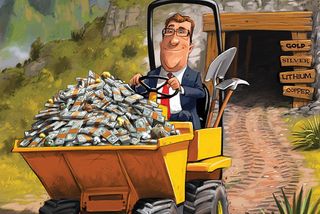The lure of Latin America: get set for a new mining boom
Latin America has long been fertile, yet dangerous territory for mining investors. But now the legal backdrop is improving and the prospects for the region’s main metals are excellent, says James McKeigue.

Latin American mining has captivated international investors for centuries. Tales of Bir, a magical gold-laden land that we now know as Peru, were enough to convince Spanish conquistador Francisco Pizarro to lead a risky expedition against the Incas. In the short-term the mission was an outstanding success: Pizarro ransomed Inca emperor Atahualpa for 13,000 pounds (lbs) of gold and twice as much silver. In today's prices that is almost £2.4bn worth of gold, though the silver comes to a paltry £6m. Since then, investors have continued to scour the region looking for similar pots of gold. The mythical El Dorado, for example, first believed to be a king, then a kingdom, finally turned out to be a waste of time and money for the British, Spanish and German investors who backed expeditions to find it.
Today the lure of Latin America's mining sector remains just as strong. Latin America has the planet's largest reserves of copper, lithium and silver, with plenty of gold to boot. Modest local demand the region comprises less than 10% of both world population and GDP makes it a natural exporter. But the conditions above ground have changed. Latin America has emerged as a mining-friendly jurisdiction with a wide range of international mining firms listed on Canadian, US, Australian and British stockmarkets. The emergence of solid democracies across the region since the 1980s has finally allowed many Latin American countries to develop fair systems to manage international mining investment. Of course, profiting from mined metals is a risky business (Pizarro ended up hacked to death, spending his final moments daubing himself with a cross in his own blood). But from solid, London-listed majors to smaller explorers looking for that next big find, Latin America has plenty to offer MoneyWeek readers.
Latin America's metal wealth
The region is incredibly rich in base and precious metals. Chile, Peru, Brazil and Mexico are particularly blessed. According to the US Geological Survey, Chile has the world's largest reserves of both copper and lithium and the seventh-largest silver stocks. Peru has the world's largest silver, third-largest copper, third-largest zinc, fourth-largest nickel and fifth-largest gold reserves. Mexico is fourth, fifth and sixth in zinc, lead and copper respectively; it is also a top-ten gold producer. Finally, Brazil has the world's second-largest stores of iron ore, the third-largest of nickel and fourth-largest reserves of tin.
Subscribe to MoneyWeek
Subscribe to MoneyWeek today and get your first six magazine issues absolutely FREE

Sign up to Money Morning
Don't miss the latest investment and personal finances news, market analysis, plus money-saving tips with our free twice-daily newsletter
Don't miss the latest investment and personal finances news, market analysis, plus money-saving tips with our free twice-daily newsletter
Beyond the established powerhouses, you also have world-class metal deposits scattered around the region. So, for example, the Dominican Republic has the world's third-biggest gold mine, while Guatemala has its second-largest silver mine. Argentina and Bolivia form part of the "lithium triangle" with Chile that together holds around 54% of global resources, which are defined as potential reserves. Moreover, it is likely that Latin America has even more mineral wealth than official statistics suggest as both political and economic turbulence have prevented international miners from exploring Argentina and Ecuador extensively.
Given that most of Peru's and Chile's largest mines are found in the Andes, it seems reasonable to suppose that their neighbours' stretches of the mountain range are also rich in minerals. I interviewed Argentina's then-mining secretary, Daniel Meiln, in Buenos Aires last year and he left me in no doubt about the country's mineral potential. "Mining makes up roughly 15% of Chile's GDP and something similar for Peru. Here in Argentina it is just 1%, despite the fact that we have a wider share of the Andes than Chile and therefore probably more minerals." We should soon find out, as in recent years both Argentina and Ecuador have changed their mining policies and opened up to investors, creating exciting new frontier markets in the region.
A bright future for copper
Latin America isn't just rich in metals it's rich in the right metals. Copper and lithium have exciting long-term prospects. I've just come back from a month researching an investment report in Peru, where everyone I interviewed seemed to be looking for a copper project. And a recent study from the market intelligence division of credit-ratings agency S&P Global notes that "for the first time since 2014 base metals matched gold as the top Latin American exploration target, with each garnering 42% of planned spending".
The rise in base metals exploration is being driven by bullishness on copper. As the commodity supercycle began to unwind in 2012, investors turned sour on copper. Its rise had been powered by massive Chinese demand, but the infrastructure glut in China, combined with efforts to move its economy away from heavy industry, seemed likely to limit future global copper use. However, the rapid growth in electric vehicles has transformed the outlook for copper. A battery-powered electric vehicle uses about 83kg of copper compared with 23kg in an internal combustion engine car. Hybrid vehicles such as the Prius are normally somewhere in the middle.
Consultant McKinsey estimates that yearly electric vehicle sales will reach 4.5 million in 2020, up from 1.2 million in 2017. That would still constitute just 5% of the overall global car market, leaving plenty of room for further growth. Copper has been hit by worries of a trade war between China and the US, and prices are still 40% below their 2011 peak.
Lithium powers electric-car batteries
Another clear winner from the transition to low-carbon energy systems is lithium. It is already established as the battery of choice for electric vehicles. The search for renewable energy's "holy grail" a cheap, efficient battery that can store excess electricity produced by intermittent sources such as wind farms and solar panels may yet give lithium another boost. Australia has managed to become the world's largest producer, despite the fact that its lithium is mined from ore, a more expensive process than extracting it from the lithium-heavy salt brines found in the lithium triangle. That's because, historically, Australia has been more welcoming to lithium investors than Chile (which treats lithium differently from copper), Argentina or Bolivia. Now that's starting to change, with Argentina in particular receiving a mix of international investment.
An opportunity in gold mining
Finally, you have gold, where I have spotted an opportunity. Alex Black, a mining industry veteran who helped investors strike it rich in Peru when he turned Rio Alto Mining Limited, his last company, from a penny stock gold developer into a billion-dollar miner, told me that he's never seen such tough financing conditions. "Trying to raise $20m for mine development now is like asking for $250m in 2013. We have more than five million ounces in resources at our Fenix Gold Project in Chile and a market cap of less than C$50m, so investors can get an ounce of gold for under $10."
Of course, a boss is bound to "talk up" his company to a journalist, but the S&P Global report backs him up. "The $9.6bn raised in 2017 and $9.4bn raised in 2018 remain well below the $19.4bn raised in 2011." One theory is that the proliferation of cannabis stocks and cryptocurrencies has diverted speculative capital from gold explorers. It's always good to have some gold in your portfolio for diversification, and judging by the desperation I encountered in Latin American gold juniors the small companies trying to develop projects low valuations mean investors can get more gold for their money at present.
Above-ground risk
Mining investors judge potential projects on "above-ground" and "below-ground" risk. Latin America's geology means it has plenty of exciting mining projects, yet the above-ground risks have often thwarted them. Latin America has been blighted by political instability ever since independence, with frequent periods of military rule; most countries have only returned to democracy within the last 40 years.
The political instability hampered mining investment because you need a stable and efficient state to create a fair mechanism for the ongoing transaction between the country's citizens the ultimate owners of the metal and the mining company. Mining has a massive environmental impact on local citizens, while there are also political and economic consequences of extracting a non-renewable resource to export for profit.
In many Latin American countries, the state's role as arbiter is complicated by the fact that strong indigenous populations have alternative concepts of land ownership, such as ancestral community territories. Those community rights are recognised in many Latin American post-dictatorship constitutions, but not clearly defined, leading to a legal standoff as miners and locals vie for a greater share of profits in proposed projects.
These political issues can have a direct impact on investors' pockets. Investors in US-listed precious metals miner Tahoe Resources learned that first-hand when it was forced to cease operating Escobal, a silver mine, because of opposition in Guatemala. Its shares plummeted and it was bought by a rival for a knockdown price earlier this year. Even well-established mining jurisdictions, such as Peru, can prove problematic. The $7bn Las Bambas copper mine was blockaded for two months this year by angry members of neighbouring communities.
Those costly lessons have taught mining companies that they need to get community relations right; investors should only consider miners that have. Last month I interviewed Victor Gobitz, boss of Buenaventura, a Peruvian firm, and he explained how it has learned to work with local groups. "If a miner just tries to exchange money for lands it is a big mistake. You need to create a long-term relationship based on generating employment for local workers and providing some social infrastructure, such as drinking water, energy, sewerage and so on."
The legal backdrop is improving
Not only are miners becoming more adept at handling these issues, but there are also signs that most Latin American states are improving their ability to regulate the relationship between investors and citizens. The Fraser Institute is a Canadian think tank that publishes a global ranking of mining jurisdictions. It judges both the mineral endowment and the policy framework to score the overall appeal for investors. Latin America and the Caribbean was the standout performer in the latest report, with the region's median investment attractiveness jumping 16% in 2018 quite a feat, given the negative weighting of basket cases such as Venezuela and Guatemala. Unsurprisingly, Chile, Peru and Mexico were in the top three. Ecuador and Colombia also made big improvements.
Still, mining policy can differ greatly within countries. Argentina's national score was poor, dragged down by the extreme anti-mining policies of some provinces, yet others, such as Catamarca, scored extremely well. Investors need to understand the local reality of a company's projects. This improving policy landscape isn't down to luck. It reflects the trend of general improvement in Latin American institutions as the young democracies across the region begin to mature. Sad cases such as Venezuela notwithstanding, most states in the region are gradually becoming more efficient, less bureaucratic, and now, thanks to the repercussions of a long-running, region-wide corruption scandal (the "Car Wash" affair in Brazil), slightly less corrupt.
Readers may be sceptical about international rankings, but my optimism is shared by international mining firms with Latin America attracting more exploration capital than any other region in the world. According to S&P Global, Latin America received 28% of the total global mining-exploration budget in 2018. Peru, Mexico, Chile, Brazil, Argentina and Ecuador jointly accounted for 90% of the region's total budget. The fact that industry insiders are targeting Latin America for future projects shows that the region is fertile ground for profit-hunting investors. We look at some of the best ways to play it below.
The stocks to buy now
Thanks to the wide range of Latin America-focused mining companies listed on Western exchanges, investors have plenty to choose from. For the most risk-averse the safest option is a UK-listed major. Fresnillo (LSE: FRES) is the world's largest silver producer and Mexico's second-largest gold miner. It boasts six world-class mines and last year silver and gold production hit record highs.
The stock has fallen by 54% over the last two years as investors have fretted about low-ore grades in some of the old mines. Those fears are overdone. Fresnillo has below-industry average production costs, an excellent record of extending mines to boost output, and is prudently managed with no debt maturing before 2023. It's a solid earner with a dividend of 2.1% and a relatively safe way to play Latin American precious metals.
An other option is Buenaventura (NYSE: BVN), which mines copper, gold and silver from a mix of small, wholly owned mines and shared mega-projects in Peru. It is in the middle of a cost-cutting programme that has boosted profitability. An extensive pipeline of development projects should fuel future growth.
Moving down to Chile you have Antofagasta (LSE: ANTO), a copper producer in Latin America's top-ranked mining jurisdiction. Its two largest deposits, Los Pelambres and Centinela, provide most of the group's four billion tonnes of copper-ore reserves. With ample scope for organic expansion, the geological risk is removed from the investment, with your major worry management's ability to execute the billion-dollar extension programmes. It also offers a generous 3.7% dividend yield.
If you fancy taking a more Francisco Pizarro approach to risk management then the region is dotted with smaller explorers. London-listed Solgold (LSE: SOLG), focused on copper, is at the forefront of Ecuador's mining push. It is developing its first property.
Of course, in a frontier market there is plenty of political risk. The shares recently fell when Ecuadorian opponents requested a referendum on regional mining, but then rose when the Constitutional Court ruled in the industry's favour.
Given his record you'd be tempted to back Alex Black's new venture, Rio 2 Limited (CVE: RIO), with a Chilean gold deposit of more than five million ounces. The risk is that the company won't be able to raise the money for development or could be forced to sell more equity, diluting your stake.
Finally, there is lithium. Chilean producer Sociedad Qumica y Minera de Chile (NYSE: SQM) is one of only two companies to have a production;[p-\ quota in the country. It also has new operations in Argentina. Building a large-scale lithium extraction plant is a tricky business, so in theory SQM should have an advantage over new entrants. In practice, though, it has often disappointed investors, so it requires thorough research. An interesting new entrant is Argentina-focused Orocobre (TSX: ORL), which produces lithium and borax, a chemical used in cleaning and pest control. Orocobre's growth will come from its plan to expand its Olaroz lithium facility. It also has a stake in Advantage Lithium (CVE: AAL), a lithium explorer with concessions in mining-friendly areas such as Catamarca.
James graduated from Keele University with a BA (Hons) in English literature and history, and has a NCTJ certificate in journalism.
After working as a freelance journalist in various Latin American countries, and a spell at ITV, James wrote for Television Business International and covered the European equity markets for the Forbes.com London bureau.
James has travelled extensively in emerging markets, reporting for international energy magazines such as Oil and Gas Investor, and institutional publications such as the Commonwealth Business Environment Report.
He is currently the managing editor of LatAm INVESTOR, the UK's only Latin American finance magazine.
-
 Barclays warns of significant rise in social media investment scams
Barclays warns of significant rise in social media investment scamsInvestment scam victims are losing an average £14k, with 61% of those falling for one over social media. Here's how to spot one and keep your money safe
By Oojal Dhanjal Published
-
 Over a thousand savings accounts now offer inflation-busting rates – how long will they stick around?
Over a thousand savings accounts now offer inflation-busting rates – how long will they stick around?The rate of UK inflation slowed again in March, boosting the opportunity for savers to earn real returns on cash in the bank. But you will need to act fast to secure the best deals.
By Katie Williams Published
-
 Invest in space: the final frontier for investors
Invest in space: the final frontier for investorsCover Story Matthew Partridge takes a look at how to invest in space, and explores the top stocks to buy to build exposure to this rapidly expanding sector.
By Dr Matthew Partridge Published
-
 These 2 stocks are set to soar
These 2 stocks are set to soarTips The returns from these two aluminium and tin stocks could be spectacular when the commodity cycle turns says David J Stevenson.
By David J Stevenson Published
-
 Invest in Brazil as the country gets set for growth
Invest in Brazil as the country gets set for growthCover Story It’s time to invest in Brazil as the economic powerhouse looks set to profit from the two key trends of the next 20 years: the global energy transition and population growth, says James McKeigue.
By James McKeigue Published
-
 5 of the world’s best stocks
5 of the world’s best stocksCover Story Here are five of the world’s best stocks according to Rupert Hargreaves. He believes all of these businesses have unique advantages that will help them grow.
By Rupert Hargreaves Published
-
 The best British tech stocks from a thriving sector
The best British tech stocks from a thriving sectorCover Story Move over, Silicon Valley. Over the past two decades the UK has become one of the main global hubs for tech start-ups. Matthew Partridge explains why, and highlights the most promising investments.
By Dr Matthew Partridge Published
-
 Could gold be the basis for a new global currency?
Could gold be the basis for a new global currency?Cover Story Gold has always been the most reliable form of money. Now collaboration between China and Russia could lead to a new gold-backed means of exchange – giving prices a big boost, says Dominic Frisby
By Dominic Frisby Published
-
 A lesson for investors from a ill-fated silver mine
A lesson for investors from a ill-fated silver mineAnalysis Mining methods may have changed since the industry’s early days, but the business hasn’t – digging ore from the ground and selling it at a profit. The trouble is, says Dominic Frisby, the scams haven't changed either.
By Dominic Frisby Published
-
 How to invest in videogames – a Great British success story
How to invest in videogames – a Great British success storyCover Story The pandemic gave the videogame sector a big boost, and that strong growth will endure. Bruce Packard provides an overview of the global outlook and assesses the four key UK-listed gaming firms.
By Bruce Packard Published